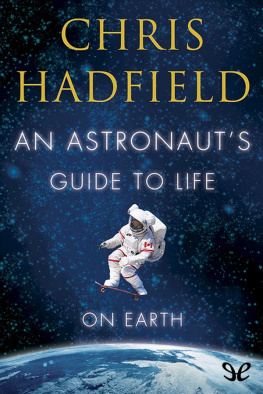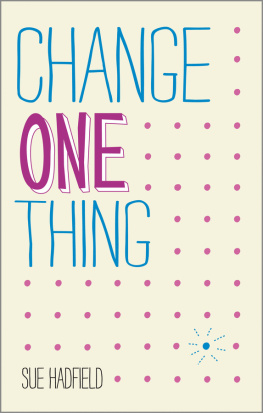Chris Hadfield - You Are Here: Around the World in 92 Minutes
Here you can read online Chris Hadfield - You Are Here: Around the World in 92 Minutes full text of the book (entire story) in english for free. Download pdf and epub, get meaning, cover and reviews about this ebook. year: 2014, publisher: Little, Brown and Company, genre: Romance novel. Description of the work, (preface) as well as reviews are available. Best literature library LitArk.com created for fans of good reading and offers a wide selection of genres:
Romance novel
Science fiction
Adventure
Detective
Science
History
Home and family
Prose
Art
Politics
Computer
Non-fiction
Religion
Business
Children
Humor
Choose a favorite category and find really read worthwhile books. Enjoy immersion in the world of imagination, feel the emotions of the characters or learn something new for yourself, make an fascinating discovery.

- Book:You Are Here: Around the World in 92 Minutes
- Author:
- Publisher:Little, Brown and Company
- Genre:
- Year:2014
- Rating:3 / 5
- Favourites:Add to favourites
- Your mark:
- 60
- 1
- 2
- 3
- 4
- 5
You Are Here: Around the World in 92 Minutes: summary, description and annotation
We offer to read an annotation, description, summary or preface (depends on what the author of the book "You Are Here: Around the World in 92 Minutes" wrote himself). If you haven't found the necessary information about the book — write in the comments, we will try to find it.
You Are Here: Around the World in 92 Minutes — read online for free the complete book (whole text) full work
Below is the text of the book, divided by pages. System saving the place of the last page read, allows you to conveniently read the book "You Are Here: Around the World in 92 Minutes" online for free, without having to search again every time where you left off. Put a bookmark, and you can go to the page where you finished reading at any time.
Font size:
Interval:
Bookmark:

In accordance with the U.S. Copyright Act of 1976, the scanning, uploading, and electronic sharing of any part of this book without the permission of the publisher constitute unlawful piracy and theft of the authors intellectual property. If you would like to use material from the book (other than for review purposes), prior written permission must be obtained by contacting the publisher at permissions@hbgusa.com. Thank you for your support of the authors rights.

With love to Eleanor and Roger, my mom and dad,
who bought me my first camera, but more importantly
taught me to be curious about the world.


In 1519 Ferdinand Magellan set sail from Spain to look for a new westward route to Asia. He (and many other sailors) didnt survive the journey. But three years later, what remained of his crew made it home, having completed the first circumnavigation of the globe. Logbooks from the voyage were a revelation, the most complete record yet of our planets infinite variety.
Nearly 500 years later, the International Space Station completes an orbit of our planet every 92 minutes16 circumnavigations a day. The ISS is a busy scientific laboratory and NASA budgets zero time for photographing Earth, but there are dozens of cameras on board and astronauts use them daily. The impulse is one Magellan and his crew would recognize: to recordand sharethe wonders of the Earth.
Those wonders are endless. My final space mission lasted five months, from December 2012 to May 2013, yet I never tired of looking out the window. I dont think any astronaut ever has, or will. Every chance we have, we float over to see whats changed since we last went around the Earth. Theres always something new to see because the planet itself is rotating, so each orbit takes us over different parts of it. Every crossing of the Pacific, every landfall, brings different weather and vegetation and lighting. And as the seasons change, sunlight, snow and new plant life create new patterns the world over.
During 2,597 orbits of our planet, I took about 45,000 photographs. At first, my approach was scattershot: just take as many pictures as possible. As time went on, though, I began to think of myself as a hunter, silently stalking certain shots. Some eluded me: Brasilia, the capital of Brazil, and Uluru, or Ayers Rock, in Australia. I captured others only after methodical planning: Today, the skies are supposed to be clear in Jeddah and well be passing nearby in the late afternoon, so the angle of the sun will be good. I need to get the long lens and be waiting at the window, looking in the right direction, at 4:02 because Ill have less than a minute to get the shot. Traveling at 17,500 miles per hour, the margin for error is very slim. Miss your opportunity and it may not arise again for another six weeks, depending on the ISSs orbital path and conditions on the ground.
Over time, my ability to understand what I was seeing improved. I started to look forward to certain places and lighting conditions, in the way you love to hear a favorite piece of music. I began to get Natures sly jokes: rivers that looked like letters of the alphabet, pieces of land that resembled animals. I became more adept at noticing and interpreting the secrets Earth was discreetly revealing.
My ability to photograph what I was seeing also improved. I started to figure out how to compose a shot in a way that draws attention to particular features and textures. I didnt think of myself as the next Ansel Adams, but I didnt want my pictures to look like satellite images, either. I wanted them to have a human element, to express a point of view.
Like many astronauts, I felt compelled to try to communicate what I was learning, so from orbit, I began posting photos on Twitter and other social media sites. The immediacy of the reactions and interactions, the collective sense of wonder, made me feel as connected to our planet and to other people as I ever have, though I was floating 250 miles above Earth in the company of just five other human beings.
Then I returned from space and started organizing my photos, and promptly came across about a thousand that I wished Id posted online. I printed out a few to show my family, and was struck by how different they looked on paperso much sharper and more detailedthan they had on the screen of my laptop. So I tried printing out some of the photos I had posted, and quickly realized I was noticing entirely different things than I had when I was back on the ISS, pressing the shutter. All of which explains the book youre holding in your hands. These are some of my favorite photosthe majority are new, and all are newly framed with my reflections and explanations.
Like many people, I want to understand our world better. Seeing it from a different angle really helps, and no perspective is more radically different than the one you get when you leave the planet altogether and look backwhether literally, as I did, or through photographs. Those spectacular, two-thousand-mile views make you a lot more aware of the big picture.
Every landscape, whether man-made or wholly natural, has a backstory. Going to space forced me to figure some of them outand doing that has changed, irrevocably, the way I perceive the world. For instance, I have a much deeper appreciation for the immensity of time. Today, driving down the highway near my house, I pass a hill and register not just a hump of rocky soil, but also the glacier that clawed and bumped it into existence thousands of years ago. I recognize the vast lakes and rivers near my home for what they really are: comparatively puny remnants of an enormous inland body of water, whose traces I saw from the ISS.
Being able to perceive the narrative line behind our planets shapes, shadows and colors is a bit like having a sixth sense. It provides a new perspective; we are small, so much smaller even than we may have thought. To me, thats not a frightening idea. Its a helpful corrective to the frantic self-importance we are prone to as a speciesand also a reminder to make the most of our moment on this beautiful, strange, durable yet fragile planet.
Through astronaut photography, not just mine but the millions of images archived by NASA and the untold number yet to come, all of us can be explorers, continuing to poke into the worlds hidden corners and turn over its mysteries. There are still plenty of those: most of the Earth has been mapped but, to many of us, it remains largely unknown, though its the only home we will ever have.
You are herewe all arefor life. Lets get to know the place a little better.


Maps tell us that North is up and South is down. But from the window of a spaceship you see that North and South are not fixed realitiesas with lines of latitude and longitude, theyre reference points invented by humans to help us navigate the world. Your frame of reference is no longer the same when youre orbiting our rotating planet, and the endless curve of the Earth is stretching and warping familiar shapes to the point where theyre not recognizable. Where should the North arrow point: to the Moon? The Sun? Another galaxy altogether? It can be disorienting to see the world from a perspective thats so different from the two-dimensional drawings were used to. But resist the impulse to turn this book upside down to make it conform to Earthly maps and youll see our planet in a new way: as it really is, universally speaking.
Font size:
Interval:
Bookmark:
Similar books «You Are Here: Around the World in 92 Minutes»
Look at similar books to You Are Here: Around the World in 92 Minutes. We have selected literature similar in name and meaning in the hope of providing readers with more options to find new, interesting, not yet read works.
Discussion, reviews of the book You Are Here: Around the World in 92 Minutes and just readers' own opinions. Leave your comments, write what you think about the work, its meaning or the main characters. Specify what exactly you liked and what you didn't like, and why you think so.








